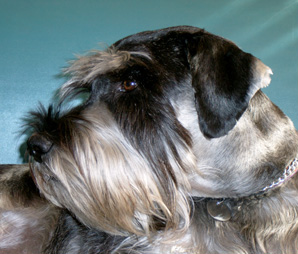
Standard Schnauzer
Group: Working Dogs
Origin: Germany
Height: 18 to 20 inches (46-51 cm)

Max
Photo credit: Clarke Isackson
CLICK HERE to View Breeder Listings
Breed Profile
The Standard Schnauzer is the oldest of the three breeds of Schnauzers, the other two being the Miniature Schnauzer and the Giant Schnauzer. The breed is native to Germany and was used as a barnyard ratter and guard dog. He was first introduced to North America in the 1920s and was originally classified as a terrier but was transferred to the Working Group in 1945.
He is known as “the dog with the human brain”, noted for his bravery and devotion. The Standard Schnauzer is an active, strong, and robust dog who makes a good family companion and needs lots of regular exercise — at a minimum, an hour of hard play a day (swimming, running, hiking, playing fetch, etc.), a leisurely stroll once a day is not enough for this active breed.
The Standard Schnauzer is truly versatile — Today, he is still used as a guard dog and he is also seen competing in conformation, obedience, tracking, and agility. In addition, he is seen working in Search and Rescue and his calm and sensitive disposition make him ideal to work as a Therapy Dog.
In appearance, he is a medium size dog with a very aristocratic look. The outer coat is harsh, hard and wiry with a soft undercoat. The coat is longer on the muzzle and over the eyes, forming a beard and eyebrows. His colouring is either salt and pepper or solid black.
Health Issues
The Standard Schnauzer is known to be a very healthy breed with an average life expectancy is 13 to 16 years. However, like all breeds of dogs, certain health disorders have been seen in the breed, including Hip Dysplasia and some eye problems.
If you are considering the adoption of a Standard Schnauzer puppy, or any breed, it is very important to be selective in choosing a responsible and reputable breeder. Ensure that the prospective puppy’s parents have all health clearances. Breeding of any dog should not be done until after they have been proven to be free of evidence of significant hereditary diseases. The Standard Schnauzer Club of America recommends that all breeding stock be x-rayed free of hip dysplasia and that eye exams be performed annually. (For more information on selecting a breeder, see the articles on the main General Information page.)
Additional Health Resources:
- Canine Health Information Center (CHIC) — Providing a source of health information for owners, breeders, and scientists that will assist in breeding healthy dogs. CHIC is a centralized canine health database jointly sponsored by the AKC/Canine Health Foundation (AKC/CHF) and the Orthopedic Foundation for Animals (OFA).
- Health and Nutrition — Growing section of the Canada’s Guide to Dogs website which includes information on several health and nutrition related issues.
- AKC Canine Health Foundation — Working towards developing scientific advances in canine health.
- Canine Eye Registration Foundation (CERF)
- Orthopedic Foundation for Animals (OFA)
- Ontario Veterinary College (OVC)
- University of Pennsylvania Hip Improvement Program (PennHip)
- HealthGene — HealthGene Corporation is the leading provider of veterinary DNA diagnostic services in Canada.
- Labgenvet — Laboratory of Veterinary Genetics is a Canadian diagnostic laboratory that offers a comprehensive service of DNA tests for veterinary genetic diseases.
Grooming Information
- Grooming — This section of the Canada’s Guide to Dogs website includes tips, articles and information covering all aspects of dog grooming along with a listing of Groomers from across Canada.
Training Resources
The Standard Schnauzer is a very intelligent breed with an excellent memory. They learn quickly and retain just about everything learned. If allowed to do so, however, they will try to take over. Training should be done in a consistent and firm manner but not rough.
- Training — For training information, see this growing section of the Canada’s Guide to Dogs website for tips, articles, as well as listings of training centres across Canada.
Additional Information
- Clubs, Sports & Activities — For information on the many sports and activities you can get involved in with your dog.
- Working Dogs — The Working Dogs section of the Canada’s Guide to Dogs website provides information and listings of organizations that are involved in various dog jobs, such as Guide Dogs, Therapy Dogs, Police Dogs, Protection Dogs, and much more.
*NOTE 1: CHIC – The Canine Health Information Center “is a database of consolidated health screening results from multiple sources. Co-sponsored by the Orthopedic Foundation for Animals (OFA) and the American Kennel Club (AKC) Canine Health Foundation, CHIC works with parent clubs to identify health screening protocols appropriate for individual breeds. Dogs tested in accordance with the parent club established requirements, that have their results registered and made available in the public domain are issued CHIC numbers.” To learn more, visit: www.caninehealthinfo.org
*NOTE 2: The Fédération Cynologique International (FCI) is the World Canine Organization, which includes 91 members and contract partners (one member per country) that each issue their own pedigrees and train their own judges. The FCI recognizes 344 breeds, with each being the “property” of a specific country. The “owner” countries write the standards of these breeds in co-operation with the Standards and Scientific Commissions of the FCI, and the translation and updating are carried out by the FCI. The FCI is not a breed registry nor does it issue pedigrees.
Quick Links
Get In Touch
- Email: canadasguidetodogs@gmail.com
- Email: info@canadasguidetodogs.com
- Visit us on Facebook: www.facebook.com/CanadasGuideToDogs
— CanadasGuideToDogs.com is an Amazon Associate as well as a participant in various affiliate programs, as such fees are earned from qualifying purchases.


